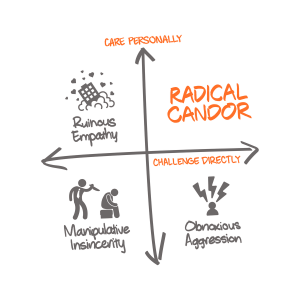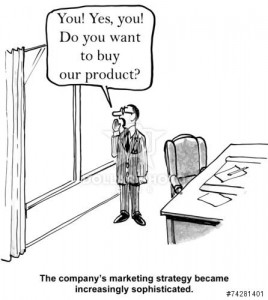Here’s how you change the conversation from “We need to sell to you” to “What customer problem are we trying to solve?”
Marketing has historically focused on what the company needs—like better sales numbers or add-on sales. While sales are important and necessary, your customers don’t care. And if they sense at all that your messaging isn’t genuine and authentic, they’ll find someone else to buy from.
Many companies are turning to agile marketing because decisions on campaigns and messaging are influenced by customer feedback instead of executives.
By focusing our marketing strategy on real reactions from customers, we create campaigns that better resonate with them.
Turning your marketing ‘outside in’
When marketers are really far removed from their customers, their messages tend to feel very corporate, stuffy and don’t resonate with potential buyers.
A few months ago, I was working with a marketing team whose company was struggling financially. When asking about their marketing goals, they couldn’t get past ‘Sell X number of widgets.’
The selling at all costs mindset was so engraved in their minds that it was extremely difficult to turn it around and look at marketing from a customer-centric lens.
So instead of being able to really get creative and listen to what their customers wanted to hear, they were stuck in the old way of working, which I call “inside out” marketing versus “
To begin changing this mindset, we began changing the conversation from “We need to sell to you” to “What customer problem are we trying to solve?”
Writing customer stories to change perspective
After working with this team at changing their goals from “inside out” to ‘”outside in,” we began breaking down their work in a similar way with customers stories, often referred to as user stories in traditional agile practices. I like to call them “customer stories” in agile marketing since we are looking at potential customers rather than users of a system or tool.
Their work was very task based in the beginning and it looked something like this:
- Write press release
- Send out email
- Write blog post
To become more
- Who is the customer?
- What are you delivering?
- Why does the customer care?
So we went from a task of “send out email” to a customer-centric viewpoint like this:
“As a restaurant owner, I want to understand how a point-of-sale system can save time so that my customers don’t have to wait in line as long.”
This simple technique can help marketers revolve their message around their customer, rather than themselves.
Creating feedback loops
Agile marketing is all about quickly getting customer feedback to inform your marketing decisions. This isn’t saying that you don’t have a plan – in fact, there’s a ton of planning that happens with agile marketing. The difference is having a flexible plan to make adjustments as you learn from your customers.
In traditional marketing, we get into detailed planning assuming we are right. With agile marketing, the goal is to learn from our customers and to make adjustments so we can get better and better at meeting their needs.
With the old way of marketing, we don’t have feedback loops anywhere. It isn’t until the end of the campaign that we learn if we hit the mark, and by then it’s too late!
A content marketing team wanted to produce a downloadable online training course as a lead magnet for their training company.
They used to plan out every module of the course and launch it with a big bang. But they were missing a key ingredient – customer feedback!
When they went to an agile approach they began testing each module with their customers. In the first week, they put together a YouTube video on the topic and gauged its interest. They then used the comments to inform them of other topics they hadn’t thought about.
They used this cycle of producing bite-sized chunks, learning from customers’ feedback and building on that to create a really awesome lead magnet.
In a world where customers have a lot of choices on where to buy products and services, it’s more important than ever that our marketing messages are authentic and add value. With agile marketing, you can become more customer-centric in your approach by changing your focus outward and getting frequent customer feedback.
Opinions expressed in this article are those of the guest author and not necessarily Marketing Land. Staff authors are listed here.
Marketing Land – Internet Marketing News, Strategies & Tips
(27)
Report Post





